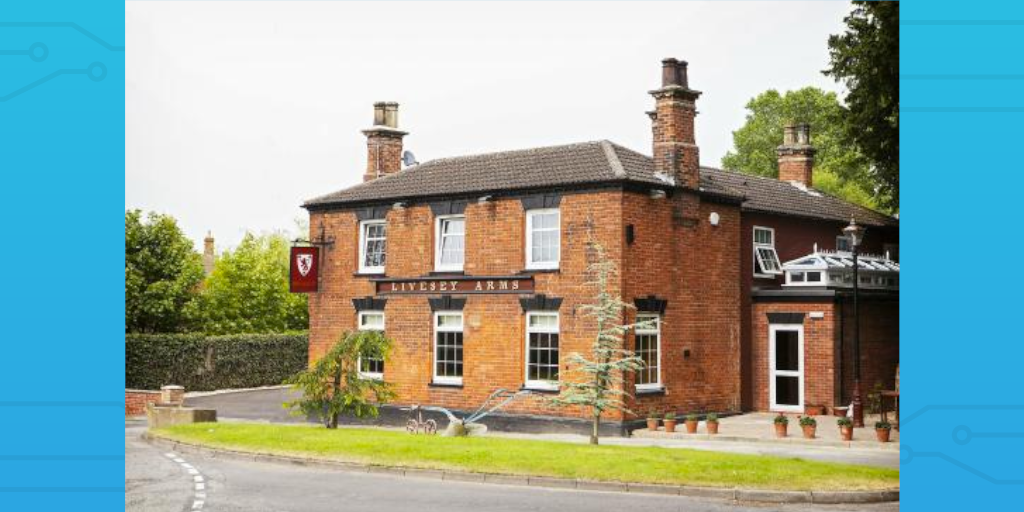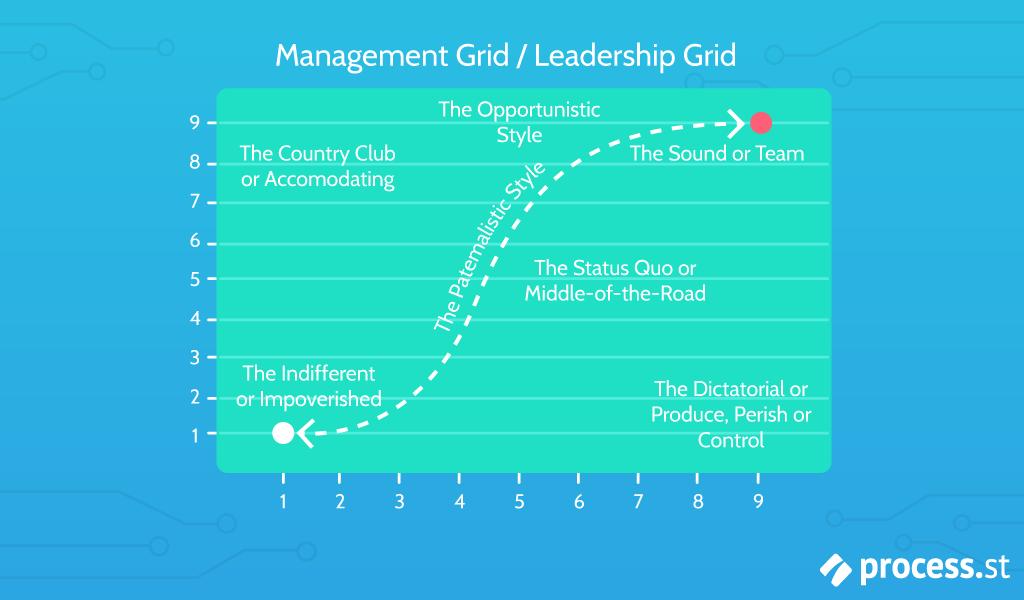
“… 71% [of organizations] said their leaders are not ready to lead their organizations into the future. Only 25% of organizations said they had a ready and willing successor identified for one out of 10 critical leader positions.” – Brandon Hall Group, State of Leadership Development 2015: Time to Act is Now
Great leadership is like electricity.
Without study, it’s a one-shot, lightning-in-a-bottle event. However, with a solid theory to explain how it works and how to harness it, you can use it to power your team like a well-oiled machine.
That’s why it pays to know your leadership theories, and why this post from the Process Street team will teach them to you.
Using these theories of leadership you can analyze your leadership style and find out what kind of leader you are and how to more effectively manage your team.
We’ll be covering:
- Great man theory
- Trait theory
- Behavioral theory
- Contingency theory
- Transactional theory
- Transformational theory
- Situational theory
- Leader-member exchange theory
- Power and influence theory
However, before we get stuck in, let’s have a quick recap on why these theories matter…
Why leadership theories matter
A good leader fuels better performance

I used to work as a waiter in my village pub-restaurant. The landlord served as head chef and manager of our team of three waiters/bar staff, one sous chef and one dishwasher.
It was the perfect first job.
The landlord got on well with everyone and allowed each team (the kitchen team and the front-of-house team) to get on largely under their own steam. This meant that we each knew what the others were good at and enjoyed, what the worst jobs were, and could organize our tasks accordingly.
Tasks were shared evenly and the worst jobs were put on a rota to make things fair. Everyone was satisfied and we were recognized as the best place to eat in a 20-mile radius on Tripadvisor.
It worked because of the landlord’s relaxed leadership approach. Experienced staff members taught the newbies and the landlord could be called on if there was a dispute to make a fair judgment.
Then it all went bottoms up.
One of the waiting staff was appointed as the Head Waiter, meaning that they got paid more and were entirely responsible for delegating tasks.
This wouldn’t have been a problem, except the person appointed as Head Waiter was the newest member of the team and spent the majority of their time talking to the landlord in the kitchen.
This left the other waiting staff (myself included) feeling sidelined, making it difficult to have the same motivation for our tasks as before.
Coupled with the fact that their talking to the chef meant that food was delayed, and that them being in the back rooms meant that everyone else was forced into specific roles to keep afloat, and we soon went down the Tripadvisor rankings.
The point is, a good leader doesn’t have to always be present in their team to encourage good performance. Equally, a bad leader can easily demotivate their team and lead to a much worse performance through no fault of the employees.
Leadership theories make complex practices simple

People are complicated. They’re hard to understand and predict at the best of times – that’s why psychology is a recognized (and challenging) field of study.
Leadership theories help to make things easier for you.
You can’t know how everyone will react to a specific situation but, by knowing more definitively what kind of leader you are (or what kind of leader you want to be), you can take more confident and effective actions in reaching your team’s goals.
It’s not rocket science – it’s basic planning.
Knowing multiple theories of leadership gives you options
Why should you care about all 11 main leadership theories if you already subscribe to one?
One word. Flexibility.
Even if you only use or believe one theory of leadership at a time, knowing what options are available will prepare you for dealing with a greater variety of situations. Not only that, but you’ll be able to interact more easily with other leaders who may subscribe to a different leadership theory or approach.
Every employee responds to different approaches
This is pretty self-explanatory.
Not every employee will respond well to the same style (or theory) of leadership. Some do better with a more direct guiding hand, others find motivation in the decision-making process.
Heck, the ideal leadership style can even vary from project to project.
Having only one leadership style or theory to fall back on when assessing your next project is therefore a pretty limiting practice. If you want to make the most of your team as it grows and changes, you need to know the lay of the land and have as much knowledge as possible at your fingertips.
With that said, let’s dive straight into the main leadership theories!
Theories of leadership
Great man theory

The theory is simple, and works on two assumptions:
- Great leaders are born, not made
- These leaders come to prominence when they are most needed
These great leaders are born with attributes that allow them to perform beyond the ability of a normal person in a leadership role. For example, they are particularly adept at managing and delegating, and are more charismatic while doing so.
They’re someone who goes above and beyond to achieve their goals despite all of the odds.
As a quick note, while this theory is generally known as the Great Man Theory due to traditional ideas of a male-dominated leadership landscape, this was later altered to Great Person theory to account for great female leaders.
Admittedly, this theory is a useful baseline when discussing leadership theories. It’s simple enough that, despite what nowadays we would consider to be fairly obvious flaws, we can at least use it as a point of comparison for the validity of other theories.
The main problem with this theory is that leaders being a result of inherent attributes (which cannot be taught) ignores all context in their upbringing, environment, and so on.
Not only that, but this also dismisses the notion of someone being tutored (or teaching themselves) to become a better leader.
The final nail in the coffin is the lack of scientific backing for the theory.
There is no evidence or verifiable explanation for how or why these leaders appear, why they’re effective or even what their inherent attributes are.
In other words, the Great Man Theory is good at making a single person feel special but this will usually come at the expense of everyone else.
Putting someone on a pedestal and saying that they’re there “because they were born for it” is a great way to alienate your team and make them feel as if they can’t do anything. They can’t strive to improve and grow into a leadership position because you’ve just told them that leaders are born, not made.
It’s important to know for the context of other leadership theories but, in practice, it’s best to stay away from Great Man Theory.
Trait theory
In my previous post solely looking at the behavioral theory of leadership I implied that trait theory was the same as the great man theory. This wasn’t entirely accurate.
Trait theory takes a very similar approach to Great Man Theory in also using Carlyle’s ideas as a basis. It, too, states that a great leader is so because of certain characteristics (traits).
Where they differ is how these traits are acquired. the Great Man theory states that these are inherited, while trait theory doesn’t specify where they come from.
In other words, trait theory acknowledges that leadership characteristics can be taught and improved rather than being entirely dependent on genetics. This gives it much greater flexibility and helps it to avoid the biggest weaknesses that Great Man theory suffers from.
The main traits that have been identified according to this theory are:
- Intelligence – perhaps the most important trait for a good leader
- Physiological factors – factors like height, weight, physique and appearance impact personality and how the leader is percieved
- Emotional stability – leaders need to be stable and confident to be seen as reliable and dependable
- Motivational drive – they need to be self-motivated and to be able to inspire the same in others
- Attention to human relations – leaders depend on their team to get work done, so they must understand the relationships their team has and how they will react to different situations
- Vision and foresight – leaders need to be able to predict trends and situations before they occur to take full advantage of them
- Empathy – this allows leaders to understand how others think and why they think that way, thus seeing the situation from another angle
- Fairness and objectivity – bias will quickly turn teams against their leaders
- Technical skills – while a leader doesn’t need to be an expert in anything, they need to have a basis in the technical skills required of their team to understand the issues they encounter
- Open mind and adaptability – leaders need to avoid being critical to encourage others to voice their point of view, even if that means adapting plans to reflect them
- Skilled communication – communication is vital to the functionality of an effective team
- Social skills – a leader with social skills will be able to interact with their team in a way that wins their loyalty and confidence, making them perform more effectively and trust the leader’s decisions more
However, despite being more applicable in modern times, trait theory still has a few core faults.
Namely, upon study, the traits of great leaders cannot be proven to be uniform in a significant way. There have also been leaders who fail to display some (or many) of the traits above.
Perhaps most damningly, trait theory doesn’t specify how prevalent each of these traits should be or give a way to test and measure them.
While it’s certainly possible that these traits contribute to good leadership from a logical point of view, the lack of quantifiable and measurable elements makes trait theory difficult to use practically.
Behavioral theory

Take trait theory and completely invert it. Behavioral theory focuses on the behaviors demonstrated by successful leaders.
This discounts any inherent traits that the leader may have – it doesn’t matter what kind of person they are as long as they demonstrate the right behavior and focus on the correct aspects. Good leadership can therefore be taught to anyone with the patience to listen and practice.
The theory came about as a result of a study in the 1940s which was carried out by Ohio State University. In this study they created the Leadership Behavior Description Questionnaire (LBDQ) to assess common behaviors in successful leaders, resulting in the first two identified leadership styles (task-oriented and people-oriented) within this behavioral theory of leadership.
There are 10 main leadership styles within behavioral theory:
- Task-oriented leaders
- People-oriented leaders
- Participative (democratic) leadership
- Indifferent (impoverished) leaders
- Country club leaders
- Status-quo leaders
- Dictatorial leaders
- Sound (team) leaders
- Opportunistic style (OPP)
- Paternalistic style
Each focuses on the types of prominent behavior in these types of leaders, almost all being identified as the result of one of three different studies. For example, the participative (democratic) leadership style focuses on communication, collaboration, and being open to feedback.
The studies forming these behavioral leadership styles are:
- The Leadership Behavior Description Questionnaire (LBDQ) by Ohio State University in the 1940s (task-oriented and people-oriented leaders)
- Several studies by Dr. Rensis Likert through the 1950s, resulting in his book New Patterns of Management (participative leadership)
- Multiple studies at Exxon performed by Dr. Jane Mouton and Dr. Robert Blake, leading to the creation of the Managerial Grid Model in 1964 (indifferent, country club, status-quo, dictatorial, sound, opportunistic, and paternalistic leaders)

For a deeper dive into behavioral theories of leadership, check out our post on the topic:
Since the theory is so broad as to encompass many different types of leaders, behavioral theory is mostly useful in identifying which type of leader someone is. This then allows them to assess whether their style can be improved or changed if the situation calls (or allows) for it.
Contingency theory
Contingency theory was created by Fred Edward Fiedler in 1964 in his essay A Contingency Model of Leadership Effectiveness.
Contingency theory isn’t as directly actionable as other, more instructional, forms of leadership theories. This is because the entire point of the theory is that there is no singular best way to lead.
Instead, this theory states that a leader is only effective when their leadership style fits the situation. This is measured by assessing the leadership style of those in your organization, then matching them to situations that complement their style.
As you might have already guessed, due to contingency theory matching leaders to situations that suit them, it assumes that leadership styles are largely set.
You’re not trying to make your leader’s style adapt to the situation. You’re trying to identify which leader’s specific style is already well-suited to it.
Fielder’s method for assessing someone’s style of leadership was to use the Least-Preferred Coworker Scale (LPC). This set of questions shows whether someone is a people-oriented leader (high LPC score) or a task-oriented leader (low LPC score).
Once their style of leadership has been assessed it can be built into a leadership map of your organization.
Situations are then assessed using the following three criteria:
- The relationship between leader and employee (Leader-Member Relation)
- How the leader sets up the tasks (Task Structure)
- The power difference between the leader and the employees/followers (Positional Power)
In particular, if there is a large Positional Power difference then task-oriented leaders will be better suited, whereas people-oriented leaders thrive when there is a close Leader-Member Relation.
Contingency theory is therefore great for large organizations with an array of leaders and projects.
Transactional theory
Transactional theory is what most people think of when it comes to typical management. This is because it focuses on leading primarily with a carrot-and-stick style.
A leader subscribing to this theory motivates those underneath them by focusing on their own self-interest.
Coined by Max Weber (not that Max Weber) in 1947, this theory is made up of four actionable elements:
- Contingent rewards – The leader sets SMART (specific, measurable, attainable, realistic, timely) goals and links rewards to those goals
- Active management by exception – The leader actively monitors the performance of their team and tries to prevent as many mistakes as possible in advance
- Passive management by exception – The leader intervenes only if their team’s performance is not up to expectations either in output or quality, sometimes giving out punishments if suitable
- Laissez-faire – The leader gives the resources and environment necessary for their team to make good decisions and avoids interfering personally
Incidentally, if you want to set SMART goals, we have a free checklist you can use to easily do just that!
You might have noticed a common thread among these elements; at no point do they imply solid relations between the leader and their team as people.
Transactional theory’s biggest flaw is in assuming that everyone can be motivated by reward and punishment.
It’s not a terrible theory to use (and it’s certainly one of the easiest to implement for the leader) but is more useful for teams who have to perform tasks with little creative input.
The simpler the goals and processes involved, and the shorter-term the projects, the better this straightforward approach will work.
For example, a manufacturing line or quality control station would be fairly well-suited to this leadership. Performance can be easily measured in terms of the units produced or assessed, and (so long as each unit isn’t too complicated) the task for producing and/or assessing each unit is easily achievable without the leader’s intervention.
Transformational theory
First coined by James Downton, transformational theory was further developed by (and is more often attributed to) James MacGregor Burns in the 1970s, and is often posed as the inverse of transactional theory.
Whereas transactional theory focuses on rewards and punishments, transformational theory involves a leader who works with their team to identify changes and lead by example largely through charisma and inspiration.
The focus is on creating a team that supports each other and is motivated by their interactions with the leader.
As such, a good transformational leader is usually highly respected and well-liked within their team. By encouraging creativity, listening to all feedback, and avoiding publicly putting down team members’ suggestions they can create a culture that motivates their team.
This is very similar to our leadership approach here at Process Street.
We open the floor to everyone and listen to suggestions. If someone makes a mistake we don’t blame them, we look for the part of the process they followed which caused the problem.
All of our team leaders can also lead by example, as all have performed the jobs of their team members either at Process Street or as part of their previous job.
There’s the catch though – to identify what causes a problem you need to have documented your processes to the point where you can easily bring them up and analyze them.
I’ll cover this in more detail later but it’s yet another reason why we use Process Street to power our team’s success!
In short, transformational theory can be effective if you have the framework set up to support it. Without carefully documented procedures it’s hard to work with your team and know exactly what they should be doing.
Not to mention that you kill two birds with one stone by encouraging your team to suggest process improvements.
Situational theory

While this at first sounds much like contingency theory, the difference is that situational theory doesn’t assume that a leader is set in a specific style.
You’re not looking for a leader to fit the situation. As a leader, you change how you lead your team to suit what’s needed of you.
Developed by Paul Hersey and Ken Blanchard, situational theory identifies four main styles of leadership and four approaches that each applies to.
The styles of leadership are:
- Telling – the leader tells employees what to do and makes decisions for them
- Selling – while the leader still makes the decisions, they persuade the team and work with them to motivate them instead of merely being directive
- Participating – the leader works with the team and makes decisions together with them
- Delegating – the leader allows their team to make the decisions but oversees their work
The leadership approaches are:
- M1 – Followers have low competence and low commitment
- M2 – Followers have low competence and high commitment
- M3 – Followers have high competence and low commitment
- M4 – Followers have high competence and high commitment
These are them paired together as follows:
- Telling – M1
- Selling – M2
- Participating – M3
- Delegating – M4
This allows the leader to be more flexible with their approach as their team improves or their commitment waxes and wanes.
Leader-member exchange theory

More specifically, this theory focuses on the psychological effect of leaders making strong bonds with some people and not others, leading to the creation of an “ingroup” and an “outgroup”. The selection process for these groups usually happens fairly early in the employee’s (or leader’s) appointment.
Those who hit it off with the new leader naturally become more trusted, potentially being seen as more capable. These people make up the ingroup. This results in the leader giving them more responsibility (sometimes through risky projects) and opportunities to develop their skills and advance their career.
Those who don’t quickly form a bond with the leader form the outgroup. This group is usually less trusted by the leader and thus is given tasks that are less challenging and less rewarding. They often have much more limited opportunities for career and personal growth.
In identifying who makes up these groups in your team you can then go about reforming the outgroup. After all, those who are more trusted and given more opportunities will naturally be more motivated and will generally perform to a higher level.
The important thing is to assess why you’ve placed these people into the outgroup and to assess whether there’s any legitimate reason for doing so. If there is not, you (or whoever the leader in this situation is) need to take the time to build a relationship with those employees.
By speaking to them individually and finding out what they like about their position you can see what motivates and interests them. Once you know that, you can start to give them the resources and opportunities they need to improve and grow.
As a result, this is a great theory of leadership to try out if you notice that some members of your team are more distant and contribute less than the rest of the team.
It’s your responsibility as a leader to help your team to be the best they can be.
Power and influence theory
Power-and-Influence leadership theory focuses on how leaders can motivate their team by using (surprise, surprise) their power and/or influence.
The main study supporting this theory in action was conducted by John French and Bertram Raven in 1959. They identified five forms of power:
- Coercive power
- Reward power
- Legitimate power
- Referent power
- Expert power
Coercive power is one of the least effective and most commonly abused kinds of power. It usually takes the form of threats from the leader to coerce the employee into doing something that they don’t want to do.
Reward power is much the same, except the leader motivates their team by offering rewards based on the tasks they assign. This works better than coercion and doesn’t cause the same dissatisfaction, however you then face the problem that your rewards need to consistently increase or else your team will become used to them, and therefore less motivated.
Legitimate power is a result of the team feeling responsible to management and obligated to complete their tasks. This is one of the more common types of power demonstrated in French and Raven’s study, and is usually accompanied by a traditional system of reward and punishment.
Sadly, legitimate power is only a factor for as long as the leader maintains their position. The leader loses this power as soon as they change role, and in terms of coercing employees to do tasks they don’t want to do, it’s a very weak element.
Referent power is where things start to become more universally useful. This forms where the leader can make someone feel accepted or like their work is important.
Think of referent power as a kind of celebrity factor – it primarily relies on charm or a kind of hero-worship factor. This is useful in conjunction with other types of power but is easy to abuse, which will typically result in a loss of faith in the leader.
Expert power is by far the most important. This power comes as a result of a large amount of knowledge and expertise in their relevant field, resulting in natural respect of their seniority.
Expert power makes leaders more effective in directing others and rewarding them appropriately due to their knowledge. They know what needs to be done, how difficult it is, how long it should take, and can give advice where needed.
In short, power-and-influence theory is useful for showing leaders what type of power is most effective (and for learning what type of power you wield). However, in terms of letting you improve your leadership style, the main takeaway can be summarized thusly:
- If you want the respect and loyalty of a motivated team, you need to improve your knowledge, experience, and expertise in the area they work.
Putting leadership theories into practice
Now that you know the theories of leadership you can start to put them into practice.
Here’s where the real hard work comes in.
Why trying to enforce or alter your leadership style you need to be able to consistently keep to the principles behind the leadership theory you’ve chosen. To do that, you need to build supporting practices into your day-to-day tasks and wider goals.
That’s where Process Street comes in.
Process Street is a powerful piece of BPM software lets you build superpowered checklists to detail, control, and track exactly how you and your team achieve their tasks.
By recording a regular process as a template, these checklists can be run as single instances of that process. This lets your team follow the process to the letter while letting you actively track the progress on their specific run of the process.
For example, you could document your regular team meeting process. In this process you’d have a list of tasks to complete to carry out the meeting as effectively as possible.
You could include videos and detailed instructions to help whoever’s using the process to prepare carefully for the meeting. Then, once the meeting is in progress, a task could be set up with form fields to record notes during the meeting and provide some extra context.
If you don’t want to spend all that time setting up your process, don’t worry! We have a free premade process you can use, along with many others on every topic from employee onboarding to vehicle inspections.
This is just one of the many examples of how documenting your processes with Process Street can help you to be the best leader you can be.
Sign up for a free account today by clicking here!
What theory of leadership do you think is the best? Let us know in the comments below!







 Workflows
Workflows Forms
Forms Data Sets
Data Sets Pages
Pages Process AI
Process AI Automations
Automations Analytics
Analytics Apps
Apps Integrations
Integrations
 Property management
Property management
 Human resources
Human resources
 Customer management
Customer management
 Information technology
Information technology



Ben Mulholland
Ben Mulholland is an Editor at Process Street, and winds down with a casual article or two on Mulholland Writing. Find him on Twitter here.